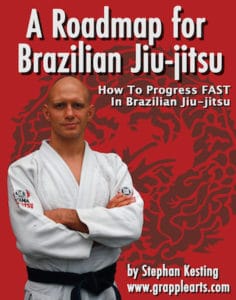Today we’re talking about passing the closed guard.
In particular, we’ll dig deep on one part of this process, because succeeding or failing at this task has decided the outcome of many matches at the highest level of competition.
In trying to pass the guard of a good player you’ve got many different tasks that you need to achieve. These include fighting for grips, establishing posture, shutting down sweeps and submissions, blocking and removing hooks, getting control over his hips, stabilising the position after the pass, etc.
But when it comes to passing the closed guard one of the hardest things is to actually break the damn thing open in the first place.
A skilled opponent will often keep his guard closed at all costs while he sets up his sweeps and submissions.
After all, he knows that if he opens up his legs then it’s just become that much easier to pass!
In my early days of training BJJ the first method I was taught to break the closed guard open involved staying on my knees. And these kneeling guard break methods do work, especially against not-so-skilled opponents.
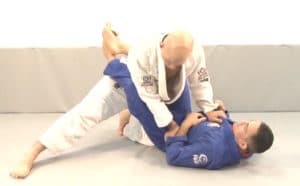
But kneeling guard breaks tend to step working as the calibre of people you’re fighting becomes better, or if you run into someone who is particularly strong and stubborn.
Against better opponents you might need to upgrade to a standing guard break where you can use the force of gravity pulling your opponent down, plus increased leverage, to crack open the most stubborn of guards.
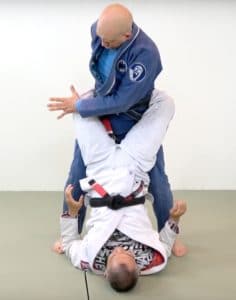
In fact, many BJJ world champions, including Marcelo Garcia, Roger Gracie and Bernardo Faria, advocate standing up to break the closed guard.
(Bernardo Faria, who passes the guard almost exclusively on his knees, still likes to stand up when he’s trying to break the closed guard and then switches to a low style of passing once the guard is open: click here for a video of him teaching this).
But even something as seemingly simple as ‘just standing up’ in someone’s closed guard isn’t really so simple when you’re doing it against resistance.
In fact, it can be really, really difficult. A savvy closed guard player will be doing everything he can to keep you from standing up.
To help you with this first part of passing the closed guard here’s a video I shot on three ways to get to an standing position when you’re in the closed guard…
If you’ve ever had problems getting to your feet against someone determined to keep you on your knees then you should definitely watch the whole video above, but here’s a quick overview of my 3 favourite ways to get to my feet when I’m trying to break open someone’s closed guard…
Standing in Closed Guard 1, Pin Biceps and Jump Both Legs
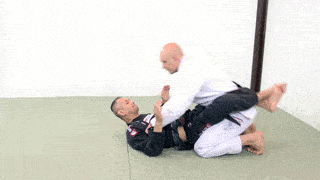
In this variation I start by either pinning both biceps using the palms of my hands, or grabbing his lapels and stuffing them into his armpits. Both of these grips somewhat limit his ability to get good grips, and also provide a platform onto which I can rock my weight for the next step.
Then I rock my weight forward until my face roughly comes over his chin area. This shifts my weight onto my hands and also generate momentum which will help with the next step.
(Just don’t rock too far forward so that you don’t expose yourself to a plethora of sweeps, including the basic-but-still-very-effective balloon sweep.)
Finally I jump up with both feet at the same time into a horse stance so beloved in traditional karate and kung fu systems. Little do practitioners of those systems know that they’re actually training a guard pass when they spend long hours in the horse stance!
Standing in Closed Guard 2, Immobilise One Arm, Then Step Legs One at a Time
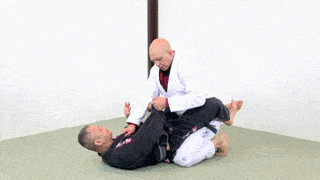
Method 2 is a tried-and-true classic where you step up with one leg at a time.
Now, the danger of going with one leg at a time is that it gives your opponent the opportunity to get an underhook on your leg, from which he has many powerful attacks like the pendulum or flower sweeps (demonstrated in the video closer to the top of this article).
Therefore it’s important that you nullify or block the arm on the side that you’re going to be stepping up first on.
For example, if I capture and stuff my opponent’s right arm, and then I’m going to step up with my left leg first. That makes it almost impossible for him to get a really deep underhook on the first leg as it steps up and keeps me much safer.
Standing in Closed Guard 3, Pin Biceps and Circle
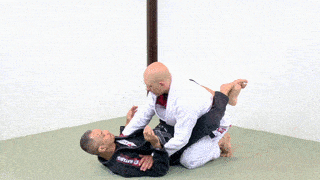
In this version you pin the biceps and then circle up onto your feet instead of staying right in front of your opponent.
This is a handy variation when your opponent is being very heavy on your upper body with his legs; for some reason circling up to your feet takes less energy than jumping up.
I wish I could remember who I learned this last variation from – it might have been MMA pioneer and grappling prodigy Carlos Newton. It worked for him and it works for me but is this technique for you? Everybody, and everybody’s body, is different, so start drilling it and see if it fits your style and your body type.
The Actual Breaking of the Closed Guard
OK, you’ve got to your feet, but what do you do now?
How do you actually uncross the ankles from around your back so you can get on with the guard pass itself?
There are different ways to accomplish this… In the two videos below I go into the standing closed guard break that I use most often.
It involves letting go of your grips, pushing one knee down and digging behind your body with your other hand. Check it out:
What Guard Passes Should You Use After Breaking the Closed Guard Standing?
The short answer to this is ‘any of them!’
You’ve stood up to break the guard so you can stay on your feet and use a standing guard pass, or you can drop back down to your knees and use a kneeling style of guard pass.
It’s up to you: once the closed guard is open then you can go to any of your favourite guard passes, including the toreando, over-under, cartwheel pass, an active posting pass, old school pressure pass, or any other guard pass you like, it doesn’t really matter!
Hope this was helpful!
Click here if you would like more tips, tricks and techniques (as well as a free copy of my guide to learning BJJ fast called The Roadmap for BJJ).
I get great feedback from grateful readers about these resources every day, so I think there’s a very good chance you’ll get at least one good nugget to take your game to the next level!
The post The Most Powerful Way to Break a Stubborn Closed Guard appeared first on Grapplearts.

